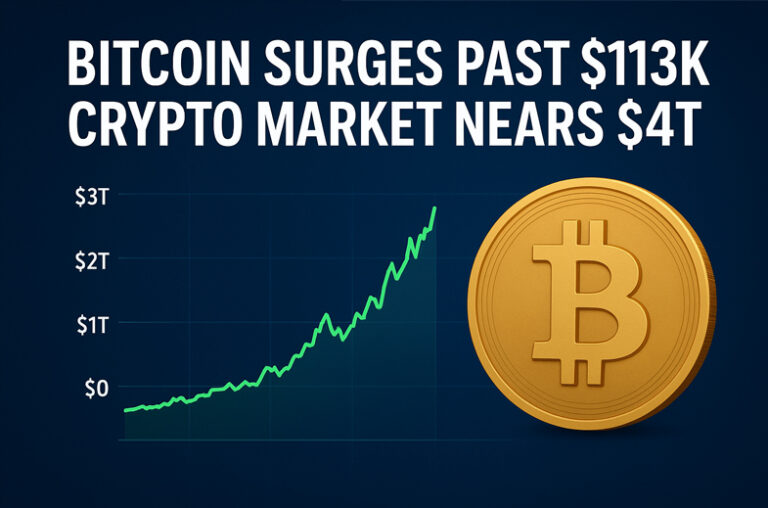Premium Biz Post – The cryptocurrency world is once again abuzz with excitement as Bitcoin surges past $113K in total valuation. This remarkable rally marks one of the strongest comebacks of the digital asset market since the mid-2020s, driven by renewed investor confidence, regulatory developments, and growing institutional interest.

A Record-Breaking Comeback
Bitcoin’s sharp rise to over $113,000 has reignited enthusiasm across the financial landscape. Over the past few weeks, Bitcoin has steadily climbed from around $95,000 to the current level, breaking multiple resistance points that traders had been watching closely. Analysts suggest that this surge reflects a mix of macroeconomic optimism, reduced inflation concerns, and growing demand for alternative assets amid global financial uncertainty.
Ethereum, the second-largest cryptocurrency by market capitalization, also experienced a notable increase, rising above the $4,000 mark for the first time since early 2024. Meanwhile, altcoins such as Solana, XRP, and Avalanche have followed suit, contributing to the global crypto market capitalization inching toward the $4 trillion milestone.
Institutional Players Fueling the Rally
One of the most significant factors behind this bullish trend is the influx of institutional investors. Major hedge funds, pension funds, and asset management firms have started to reallocate capital into Bitcoin and other digital assets, viewing them as hedges against fiat currency depreciation and geopolitical instability.
The approval of several Bitcoin Exchange-Traded Funds (ETFs) in both the United States and Europe earlier this year has also added momentum. These financial instruments allow traditional investors to gain exposure to Bitcoin without directly holding the asset, significantly broadening participation in the crypto market.
“Bitcoin’s current trajectory is not merely speculative,” explains Laura Jenkins, a financial analyst at GlobalDigital Insights. “We are witnessing the maturation of the asset class as institutions continue to treat it as a legitimate store of value, similar to gold in the 1970s.”
Macroeconomic Conditions Encourage Crypto Growth
The rally in digital assets comes at a time when global economic conditions are undergoing major shifts. Central banks around the world are gradually lowering interest rates after several years of tight monetary policies. This easing has encouraged risk-on sentiment among investors, driving them toward high-yield assets, including cryptocurrencies.
Furthermore, global concerns about government debt and fiscal deficits have intensified the appeal of decentralized currencies. With countries like the United States, Japan, and several in the European Union facing record debt levels, Bitcoin’s capped supply of 21 million coins has become a compelling alternative to inflation-prone fiat systems.
In addition, the weakening of the U.S. dollar index in recent months has pushed more traders and institutions to diversify their portfolios with digital currencies. Historically, Bitcoin tends to perform well during periods of dollar weakness, and the current trend aligns with that pattern.
Regulatory Shifts Offer Clarity and Confidence
Regulatory clarity has long been a key driver of confidence in the cryptocurrency sector. Recently, India’s Madras High Court made headlines by officially recognizing cryptocurrency as a form of property under Indian law. This landmark ruling provides legal protection for holders of digital assets and signals a shift toward greater mainstream acceptance.
In the United States, the Securities and Exchange Commission (SEC) has begun establishing clearer frameworks for token classification and exchange oversight. While some regulatory challenges remain, the general tone has shifted from restriction toward responsible inclusion within the broader financial ecosystem.
These developments have reassured both retail and institutional investors, who previously viewed the absence of clear regulation as a major risk factor. With countries across Asia, Europe, and the Americas adopting more transparent crypto laws, market participants are now more confident about long-term stability.
Read More : ”Indonesia Handicraft Industry Local Creativity with Global Recognition”
Technological Advancements Reinforce Bitcoin’s Dominance
Beyond macro and regulatory influences, ongoing technological innovations within the blockchain space continue to strengthen Bitcoin’s position as the market leader. The adoption of the Lightning Network has drastically improved Bitcoin’s transaction speed and cost efficiency, making it more viable for everyday payments.
Meanwhile, advancements in decentralized finance (DeFi) and tokenized assets have created new ecosystems where Bitcoin can serve as collateral or be integrated into smart contracts. These use cases expand Bitcoin’s utility beyond a mere speculative investment.
Moreover, the upcoming “Halving” event—expected in mid-2026—is already influencing market sentiment. Historically, Bitcoin halving events, which reduce block rewards for miners, have been followed by substantial price increases due to reduced supply. Investors anticipating this pattern may already be positioning themselves for potential long-term gains.
Altcoins and Stablecoins Gain Traction
While Bitcoin continues to dominate headlines, the broader crypto market’s growth is being propelled by significant movement in other sectors. Stablecoins, which are pegged to fiat currencies, have seen an unprecedented rise in circulation. They are becoming essential tools for global payments, remittances, and decentralized finance protocols.
On the other hand, Layer-1 and Layer-2 projects such as Ethereum, Solana, and Polygon are expanding their ecosystems through faster transaction speeds and lower costs. These networks are attracting developers and users looking for scalable solutions, pushing the industry closer to mainstream adoption.
NFTs (non-fungible tokens), though less hyped than during their 2021 peak, are quietly regaining traction in the art, gaming, and fashion sectors. Big brands like Nike, Gucci, and Samsung continue experimenting with blockchain-based digital assets, signaling that the NFT market is evolving toward more sustainable use cases.
Risks and Volatility Remain
Despite the bullish momentum, experts caution that cryptocurrency remains one of the most volatile asset classes. Bitcoin’s recent 15% week-over-week surge, while impressive, could be followed by sharp corrections. Analysts point to leveraged positions and speculative trading as potential triggers for short-term downturns.
Furthermore, geopolitical tensions, cybersecurity risks, and potential regulatory overreach in certain jurisdictions could disrupt the market’s progress. For example, stricter tax enforcement or anti-money-laundering measures could temporarily dampen enthusiasm, especially among smaller investors.
Therefore, financial advisors continue to recommend portfolio diversification and risk management strategies for anyone considering crypto investments. As with any high-volatility asset, understanding the underlying fundamentals is key to navigating price swings effectively.
Global Crypto Adoption Continues to Expand
Despite these challenges, global crypto adoption shows no signs of slowing down. Emerging markets such as Indonesia, Brazil, Nigeria, and Turkey are witnessing exponential growth in crypto usage, driven by high inflation rates and limited access to traditional banking systems.
In Southeast Asia, digital wallets and crypto exchanges are integrating services that allow seamless transitions between fiat and crypto. This trend is especially notable in Indonesia and the Philippines, where remittances from overseas workers contribute significantly to the economy. Blockchain-based remittance platforms offer faster and cheaper alternatives to conventional systems.
The rise of Central Bank Digital Currencies (CBDCs) in countries like China and India also complements the growth of the crypto market. While CBDCs are centralized, their existence further normalizes the concept of digital money, indirectly boosting public trust in decentralized cryptocurrencies.
Market Outlook: What Lies Ahead
Analysts are divided on how far the current bull run can extend. Some believe Bitcoin could test the $120,000 resistance level before year-end, especially if macroeconomic conditions remain favorable. Others, however, warn that overheated markets often lead to sharp pullbacks.
Long-term projections remain optimistic. As more institutions and governments embrace digital asset infrastructure, the likelihood of crypto’s integration into global finance grows stronger. With the total market capitalization approaching $4 trillion, cryptocurrencies are now undeniably part of mainstream financial discourse.
Investors and policymakers alike are closely watching this space, as the balance between innovation, regulation, and stability will define the next chapter of the crypto revolution.
The rise of Bitcoin beyond $113,000 and the near-$4 trillion valuation of the overall crypto market marks a pivotal moment in digital finance. The combination of favorable macroeconomic conditions, institutional participation, and evolving regulatory frameworks has created an environment ripe for sustainable growth.
However, caution remains necessary. The market’s inherent volatility demands discipline and awareness from investors at every level. Whether Bitcoin continues its ascent or faces a correction, one thing is clear: cryptocurrencies have solidified their place in the global financial landscape, transforming from speculative experiments into foundational assets of the digital economy.


